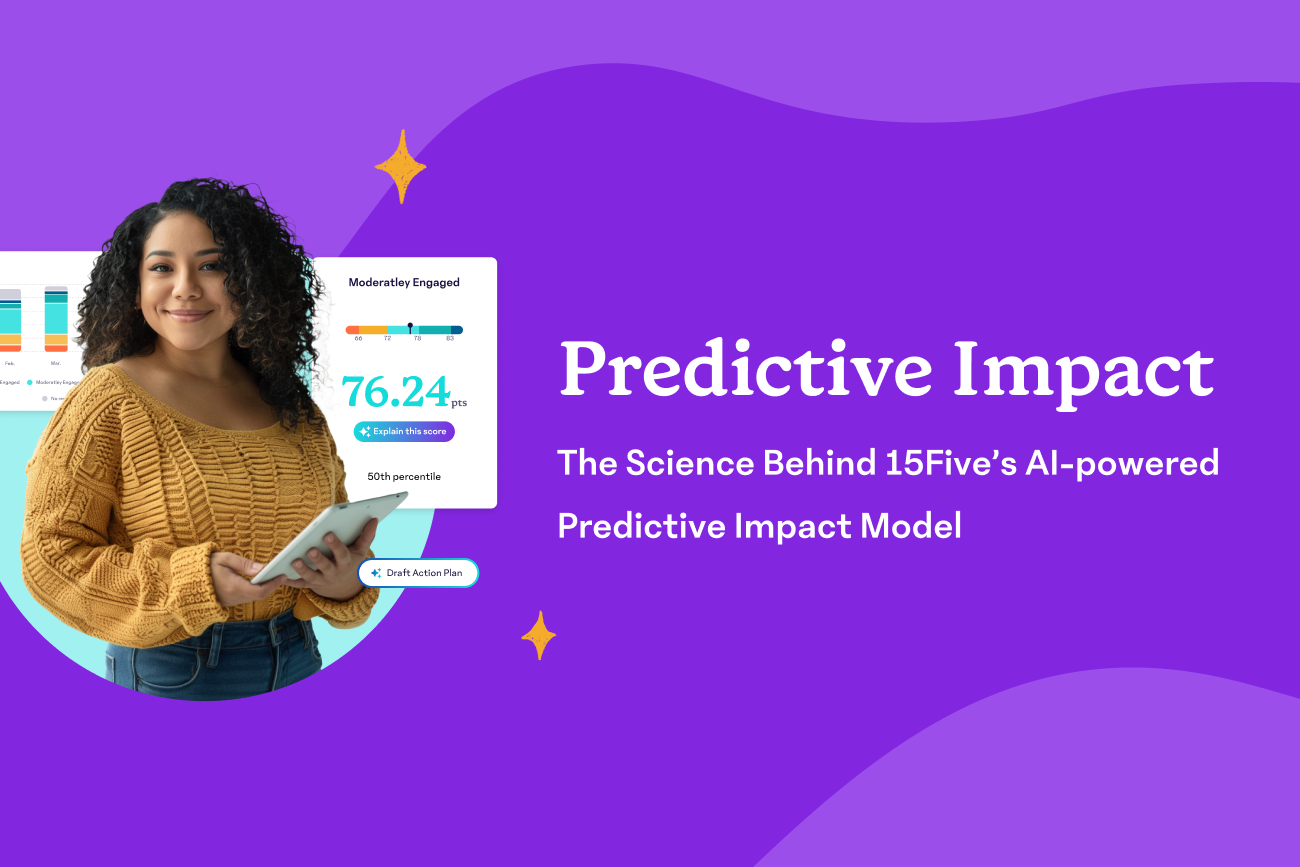The Science of 15Five: My Profile
Highlights Tab
The Highlights Tab includes a consolidated view of all 15Five “To-dos”, including when the next 15Five is due, current Objectives, recent High Fives, and (if you’re a manager) any Weekly Check-ins that are ready to be reviewed. Highlights are only visible to each employee and are not seen by their manager or Followers.
To-dos. Employees can use their To-dos list to keep track of their top priorities that need to be completed. To maximize time and performance, research from Morten Hansen, professor at UC Berkeley and INSEAD shows that employees should prioritize and select a few activities to focus on and then focus intensely on those areas. In other words, ‘do less and obsess.’
Objectives. Employees are prompted to monitor the progress of their current Objectives, which is shared publicly with the entire organization. Research shows that monitoring progress on Objectives and Key Results is just as important as creating those OKRs! The ability to see the distance from the goal is crucial, so monitoring progress is necessary for goal setting to work. Goal transparency and a focus on progress are two key research inspired features that increase motivation and the likelihood of goal achievement. Additionally, research shows that Objectives should be lightweight and flexible, so in this Objectives section, employees can also edit, adjust, and re-frame any Objective or mark them as complete.
Recently received High Fives. According to Gallup, individuals who receive recognition and praise are more productive, more engaged, more likely to stay with their organization, and receive higher loyalty and satisfaction scores from customers. We included a personalized High Five Feed in the Profile so employees can view all of their received High Fives in one place.
Engagement Tab
In the Engagement Tab, employees take a high-level view — they see a summary of all past activity and essential stats all in one place. This tab aggregates individual data for each employee since their first day using 15Five, so they can get a sense of how far they’ve come.
According to Social Comparison Theory, in both social and work settings, humans naturally compare themselves to other people. Yet, positive psychology research shows that constant comparison to others is a happiness killer. Instead, people are better off comparing themselves to their past selves.
Here, we show past personal engagement and performance activity, including Pulse trends (how employees feel at work over time) and Objectives activity (goal progress over time) so employees can easily view the arc of their trends and accomplishments. For example, the Pulse trend is a visual dashboard highlighting when things are going well and also when issues may arise. Here, employees can take a higher level monthly view to see when they felt at their best and when they struggled. We also include a summary of essential usage stats, including 15Five activity (reports submitted over time) and 1-on-1 meetings held.
Info Tab
This is a brief summary of each employee’s reporting ecosystem; what groups they belong to, who their followers are, and for managers, who’s on their team. This information will be visible to anyone that looks at this public profile.
Career Vision Tab
Job title and description. Clear expectations are the most basic and fundamental employee need, so effective performance management starts here, with a clear job description. In the Career Vision Tab, employees are encouraged to upload and review their job description, along with all other responsibilities and performance expectations with their manager. Why? According to Gallup, only 50% of employees clearly know what is expected of them at work. Yet, clarity of expectations is statistically linked to many important organizational outcomes. When this figure rises to 80%, organizations experience a 14% reduction in turnover and a 7% increase in productivity. 81% of reporters who use 15Five say they’re clearer about their role, Objectives, and their impact on their organization. Job title is visible to everyone and Job description is visible to anyone who can see an employee’s 15Five.
The Career Vision Tab will house an employee’s job title and description, as well as their top 5 strengths.
Strengths. According to Gallup, only 1 in 3 employees strongly agree that they have the opportunity to do what they do best every day. Yet, people who use their strengths every day are 6x more likely to be engaged, 8% more productive, and 15% less likely to quit their jobs. In companies where people have a chance each day to do what they do best or demonstrate their strengths, productivity is 1.5x greater.
15Five believes each individual has a “zone of genius” and our goal is to help employees identify their strengths and clearly align their day-to-day activities with what they do best to drive company initiatives forward. We recommend employees discover their top strengths through scientifically valid personality tests like StrengthsFinder and VIA Character, and in the Best-Self Review, they will gather feedback about their strengths from their peers. Strengths are visible to anyone who can see an employee’s 15Five.
Most role descriptions are rigid, company-centric, and don’t capture the essence of the role. It’s time for role descriptions to become more flexible, more employee-centric, and more comprehensive. We intentionally place an employee’s job description and strengths side-by-side so managers and employees can easily assess if the two align. If there’s a large discrepancy between an employees role and top strengths, we recommend managers and employees work together to re-align the role with what an employees does best.
Most millennials won’t get the golden ticket in their first or second role at a company, but they can do things to make their work more golden. This strengths-centric framework for role descriptions is inspired by research on Job Crafting, an exercise developed by Justin Berg from Stanford, Jane Dutton from the University of Michigan, and Amy Wrzesniewski from Yale. Job crafting helps employees redesign their roles around their strengths, values, and passions and has a substantial impact on engagement, job satisfaction, resilience, and thriving at work.
Career trajectory. In the Career trajectory section, which is private to the employee and manager, employees create an aspirational job title and job description. Words matter and many job titles don’t actually reflect the unique value people bring to their jobs every day. When employees get a say in the actual wording of their job title (their personal value prop), they’re able to express themselves more authentically. A study by Wharton Professor Adam Grant, Stanford Professor Justin Berg, and London Business School Professor Dan Cable, shows that self-reflective job titles can reduce emotional exhaustion and burnout. Employees can also write their own aspirational job descriptions and envision their ideal role and responsibilities. The Career trajectory tab can drive discussions when it comes time for quarterly or annual reviews.
Wins & Challenges Tab
The Wins and Challenges Tab allows employees to collect the most important insights from their 15Fives. Employees and managers can look back on this information when writing their Best-Self Review.
Unlocking the potential of your workforce starts here – with an employee-centric profile section where people can clarify their role description, keep track of their top priorities, view their trends and accomplishments over time, and uncover their top strengths to envision their ideal role. ‘My Profile’ is home base and the hub for all personal activity in 15Five to help employees develop into their best selves. Here, employees not only see how they’ve grown over time, but they also envision their ideal selves – and work with their managers to turn their dream career into reality.




